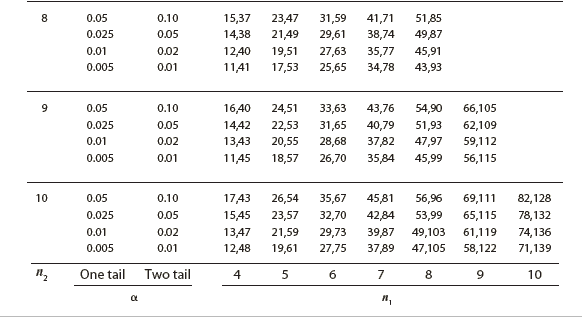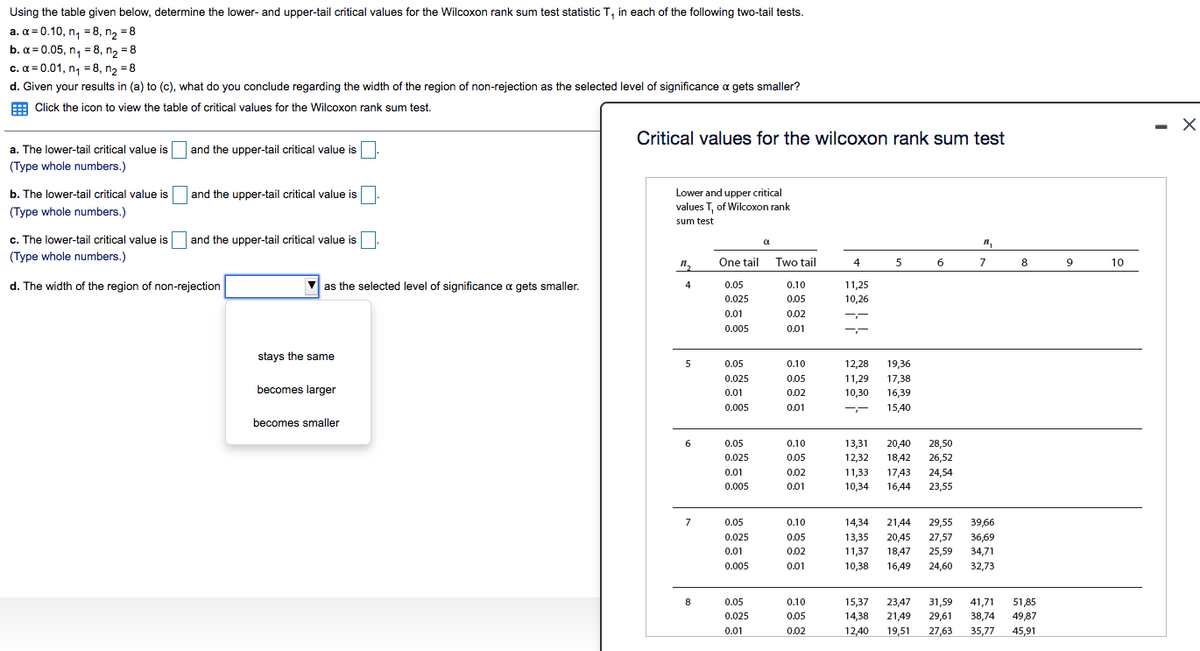Using the table given below, determine the lower- and upper-tail critical values for the Wilcoxon rank sum test statistic T, in each of the following two-tail tests. a. a = 0.10, n, = 8, nz = 8 b. a = 0.05, n, = 8, ng = 8 c. a = 0.01, n, =8, n2 = 8 d. Given your results in (a) to (c), what do you conclude regarding the width of the region of non-rejection as the selected level of significance a gets smaller? E Click the icon to view the table of critical values for the Wilcoxon rank sum test. Critical values for the wilcox a. The lower-tail critical value is O and the upper-tail critical value isO (Type whole numbers.) b. The lower-tail critical value is D and the upper-tail critical value is Lower and upper critical (Type whole numbers.) values T, of Wikcoxon rank sum test c. The lower-tail critical value is and the upper-tail critical value is. (Type whole numbers.) One tail Two tail
Using the table given below, determine the lower- and upper-tail critical values for the Wilcoxon rank sum test statistic T, in each of the following two-tail tests. a. a = 0.10, n, = 8, nz = 8 b. a = 0.05, n, = 8, ng = 8 c. a = 0.01, n, =8, n2 = 8 d. Given your results in (a) to (c), what do you conclude regarding the width of the region of non-rejection as the selected level of significance a gets smaller? E Click the icon to view the table of critical values for the Wilcoxon rank sum test. Critical values for the wilcox a. The lower-tail critical value is O and the upper-tail critical value isO (Type whole numbers.) b. The lower-tail critical value is D and the upper-tail critical value is Lower and upper critical (Type whole numbers.) values T, of Wikcoxon rank sum test c. The lower-tail critical value is and the upper-tail critical value is. (Type whole numbers.) One tail Two tail
Glencoe Algebra 1, Student Edition, 9780079039897, 0079039898, 2018
18th Edition
ISBN:9780079039897
Author:Carter
Publisher:Carter
Chapter10: Statistics
Section10.1: Measures Of Center
Problem 9PPS
Related questions
Question
Using the table given below, determine the lower- and upper-tail critical values for the Wilcoxon rank sum test statistic
T1
in each of the following two-tail tests.a.
α=0.10,
n1=8,
n2=8
b.
α=0.05,
n1=8,
n2=8
c.
α=0.01,
n1=8,
n2=8
d. Given your results in (a) to (c), what do you conclude regarding the width of the region of non-rejection as the selected level of significance
α
gets smaller?LOADING...
a. The lower-tail critical value is
enter your response here
and the upper-tail critical value is
enter your response here.
(Type whole numbers.)
b. The lower-tail critical value is
enter your response here
and the upper-tail critical value is
enter your response here.
(Type whole numbers.)
c. The lower-tail critical value is
enter your response here
and the upper-tail critical value is
enter your response here.
(Type whole numbers.)
d. The width of the region of non-rejection
as the selected level of significance
▼
α
gets smaller.
Transcribed Image Text:0.05
23,47
31,59
29,61
8
0.10
15,37
41,71
51,85
0.025
0.05
14,38
21,49
38,74
49,87
0.01
0.02
12,40
19,51
27,63
35,77
45,91
0.005
0.01
11,41
17,53
25,65
34,78
43,93
43,76
54,90
51,93
0.05
0.10
16,40
24,51
33,63
66,105
0.025
0.05
14,42
22,53
31,65
40,79
62,109
0.01
0.02
13,43
20,55
28,68
37,82
47,97
59,112
0.005
0.01
11,45
18,57
26,70
35,84
45,99
56,115
10
0.05
0.10
17,43
26,54
35,67
45,81
56,96
69,111
82,128
0.025
0.05
15,45
23,57
32,70
42,84
53,99
65,115
78,132
0.01
0.02
13,47
21,59
29,73
39,87
49,103
61,119
74,136
0.005
0.01
12,48
19,61
27,75
37,89
47,105
58,122
71,139
One tail
Two tail
4
б
7
8
9.
10

Transcribed Image Text:Using the table given below, determine the lower- and upper-tail critical values for the Wilcoxon rank sum test statistic T, in each of the following two-tail tests.
a. a = 0.10, n, = 8, n2 = 8
b. a = 0.05, n, = 8, n2 = 8
c. a = 0.01, n, = 8, n2 = 8
d. Given your results in (a) to (c), what do you conclude regarding the width of the region of non-rejection as the selected level of significance a gets smaller?
E Click the icon to view the table of critical values for the Wilcoxon rank sum test.
- X
Critical values for the wilcoxon rank sum test
a. The lower-tail critical value is
and the upper-tail critical value is
(Type whole numbers.)
and the upper-tail critical value is
Lower and upper critical
values T, of Wilcoxon rank
b. The lower-tail critical value is
(Type whole numbers.)
sum test
c. The lower-tail critical value is and the upper-tail critical value is
(Type whole numbers.)
n,
One tail Two tail
4
6
7
8
9
10
d. The width of the region of non-rejection
V as the selected level of significance a gets smaller.
4
0.05
0.10
11,25
0.025
0.05
10,26
0.01
0.02
0.005
0.01
stays the same
0.05
0.10
12,28
19,36
0.025
0.05
11,29
17,38
becomes larger
0.01
0.02
10,30
16,39
0.005
0.01
15,40
becomes smaller
6
0.05
0.10
13,31
20,40
28,50
0.025
0.05
12,32
18,42
26,52
0.01
0.02
11,33
17,43
24,54
0.005
0.01
10,34
16,44
23,55
7
0.05
0.10
14,34
21,44
29,55
39,66
0.025
0.05
13,35
20,45
27,57
36,69
0.01
0.02
11,37
18,47
25,59
34,71
0.005
0.01
10,38
16,49
24,60
32,73
8
0.05
0.10
15,37
23,47
31,59
41,71
51,85
0.025
0.05
14,38
21,49
29,61
38,74
49,87
0.01
0.02
12,40
19,51
27,63
35,77
45,91
Expert Solution
This question has been solved!
Explore an expertly crafted, step-by-step solution for a thorough understanding of key concepts.
This is a popular solution!
Trending now
This is a popular solution!
Step by step
Solved in 2 steps

Recommended textbooks for you

Glencoe Algebra 1, Student Edition, 9780079039897…
Algebra
ISBN:
9780079039897
Author:
Carter
Publisher:
McGraw Hill

Glencoe Algebra 1, Student Edition, 9780079039897…
Algebra
ISBN:
9780079039897
Author:
Carter
Publisher:
McGraw Hill